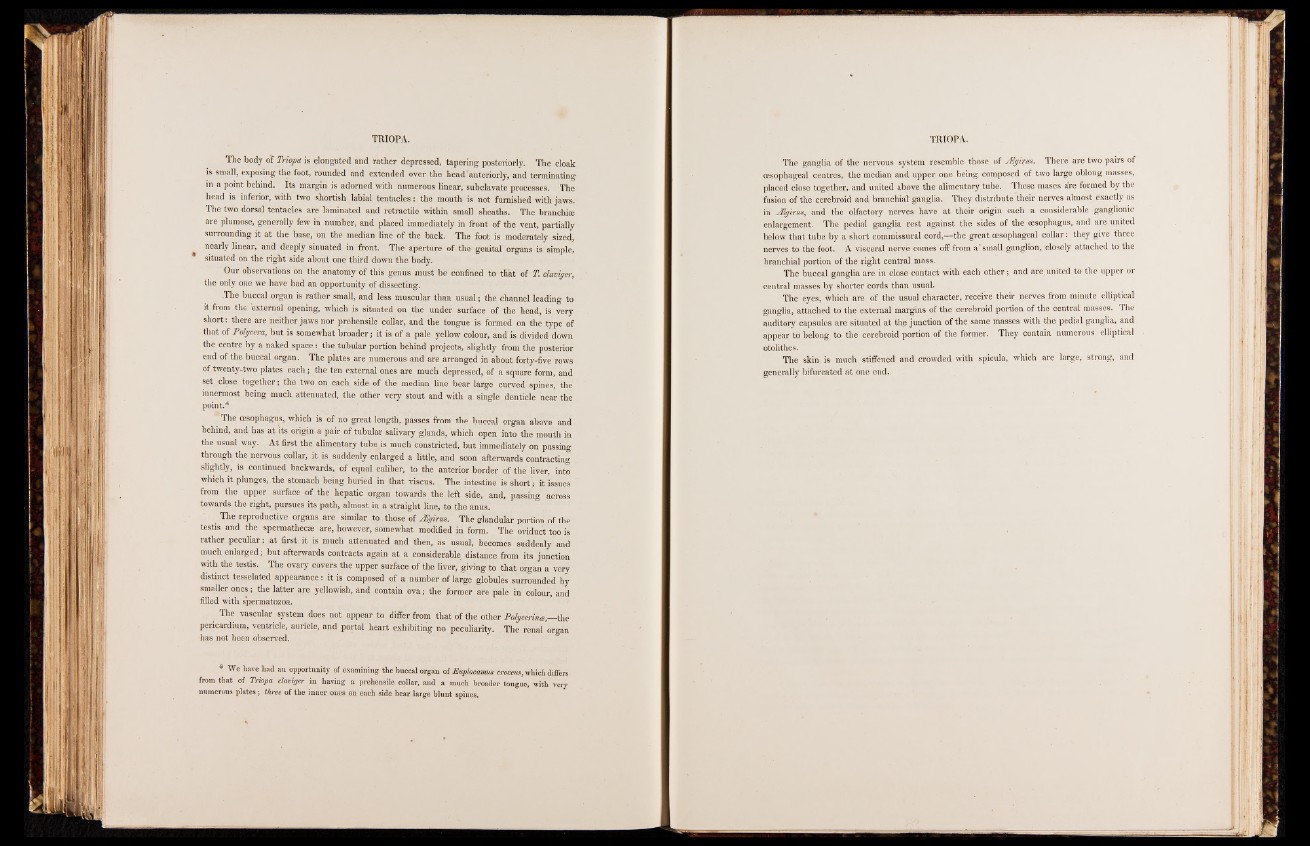
TRIOPA.
The body of Triopa is elongated and rather depressed, tapering posteriorly. The cloak
is small, exposing the foot, rounded and extended over the headvanteriorly, and terminating
in a point behind. Its margin is adorned with numerous linear, subclavate processes. The
head is inferior, with two shortish labial tentacles : the mouth is not furnished with jaws.
The two dorsal tentacles are laminated and retractile within small sheaths. The branchiae
are plumose, generally few in number, and placed immediately in front of the vent, partially
surrounding it at the base, on the median line of the back.' The foot is moderately sized,
nearly linear, and deeply sinuated in front. The aperture of the genital organs is simple,
situated on the right side about one third down the body.
Our observations on the aiiatoihy of this genus must be confined to that of T. clamger,
the only one we have had an opportunity of dissecting.
The buccal organ is rather small, and less muscular, than usual ; the channel leading to
it from the external opening, which is situated on the under surface of the head, is very
short: there are neither jaws nor prehensile collar, and the tongue is formed on the type of
that of Polycera, but is somewhat broader; it is of a pale yellow colour, and is divided-down
the centre by a naked space: the tubular portion behind projects, slightly from the posterior
end of the buccal organ. The plates are numerous and are arranged in about forty-five rows
of twenty-two plates each; the ten external ones are much depressed, of a square form, and
set.clpse together; the two on each side of the median fine bear large curved.spines the
innermost being much attenuated, the other very stout and with a single denticle near the
point.*
' The oesophagus, which is of no great length, passes from the buccal organ above and
behind, and has at its origin a pair of tubular salivary glands, which openjnto the mouth in
the usual way. At first the alimentary tube is muchconstricted, but immediately on passing
through the nervous collar, it is suddenly enlarged a little, and soon afterwards contracting
slightly, is continued backwards, of equal caliber, to jh e anterior border of the liver, into
which it plunges, the stomach being buried in that viscus. The intestine is short ; it issues
from the upper surface of the hepatic organ towards the left side, and, passing across
towards the right, pursues its path, almost in a-straight line, to the anus.
The reproductive organs are similar to. those of ^g irm . The glandular portion of the
testis and the spermatheca; are, however, somewhat modified in form. The oviduct too is
rather peculiar: at first it is much attenuated and then, ds usual, becomes suddenly and
much enlarged; but afterwards contracts.again at a considerable distance from its junction
with the testis. The ovary covers the upper surface of the liver, giving to that organ a very
distinct tesselated appearance: it is composed of a number of large globules surrounded by
smaller ones; the latter are yellowish, and contain ova; the former are pale in colour, and
filled with spermatozoa.
The vascular system does not appear to differ from that of the other Polycerinee —the
pericardium, ventricle, auricle, and portal heart exhibiting no peculiarity. The renal organ
has not been observed.
* We have had an opportunity of examining the buccal organ of Euplocamns croceus, which differs
from that of Triopa claviger in having a prehensile collar, and a much broader tongue, with very
numerous plates j three of the inner ones on each side bear large blunt spines.
TRIOPA.
The ganglia of the nervous system resemble those of JEgirrn. There are two pairs of
oesophageal centres, the median and upper one being composed of two large oblong masses,
placed close together, and united above the alimentary tube. These mases a’re formed by the
fusion of the cerebroid and branchial' ganglia. They distribute their nerves almost exactly as
in JEgirm, and the olfactory nerves have at their origin each a considerable ganglionic
enlargement. The pedial ganglia rest against the sides of the oesophagus, and are united
below that tube by a short commissural cord,—the great oesophageal collar: they give three
nerves to the foot. A visceral nerve comes off from a* small ganglion, closely attached to the
branchial portion of the right central mass.
The buccal ganglia are in close contact with each other; and are.united to the upper or
central masses by shorter cords than usual.
The eyes, which are of the usual character, receive their nerves from minute elliptical
ganglia, attached to the external margins of the cerebroid portion of the central masses. The
auditory capsules are situated at the junction of the same masses with the pedial ganglia, and
appear to belong to the cerebroid portion of the former. They contain numerous elliptical
otolithes.
The skin is much stiffened and crowded with spicula, which are large, strong, and
generally bifurcated at one end.